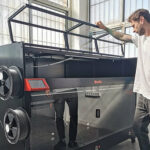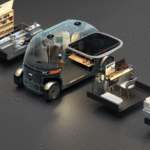The Israeli 3D printer manufacturer Massivit 3D certainly lives up to its namesake with the recent release of the Massivit 5000, capable of printing parts 1.8 meters tall. Let’s take a look inside this cave of a printer.
We are thrilled to bring to market this new additive manufacturing system that will empower manufacturers to overcome existing limitations in production speed, size, and complexity. It is a significant milestone on our roadmap towards transforming manufacturing of large parts across multiple industries.Erez Zimerman, CEO of Massivit 3D
With a build volume of 57”W x 44”D x 70”H, a printer this big is catered to the needs of a few specific industries, though we’re talking about a 3D printer so really anyone with the budget can find some use for it. Manufacturers of automotive, rail, and marine parts as well as service and repair companies in those industries will find much value in the productivity gains that can be achieved with the Gel Dispensing Printing (GDP) technology powering the 5000. So how does their printing technology work?
GDP Sets Geometry Free
GDP is like a fusion of FDM and SLA, where a photosensitive gel is extruded (sort of like FDM) and then immediately cured with powerful UV light (kind of like SLA) as it’s deposited. Unlike plastic, the gel isn’t being melted so that makes it easier for the printer to print rapidly, up to 300mm/s! And since the material is cured as it’s deposited, it can handle overhangs without supports, allowing for more geometric freedom at the design stage. The only time supports are needed is when a very large, angled part may be too heavy on one side to hold itself up without supports. In general though, significantly less support material is used with this technology, and when printing parts over a meter tall, those material savings really start to add up.
Size isn’t everything the 5000 brings to the table, however, as it’s equipped with dual extruders, enabling it to print two different materials simultaneously. They can also print at different quality levels, and each object can be printed with variable resolution as well, cutting print time while maintaining details. That’s an invaluable feature on a large-scale 3D printer.
Less Is More
While its sheer size is obviously a value add, its incredible speed (thanks in part to a lack of supports) can’t be understated, because most 3D printers take days to print what the 5000 can print in hours. Less print time means more orders fulfilled per day, and less material lost to supports means more orders fulfilled per liter of material. With the Massivit 5000, less is more.










